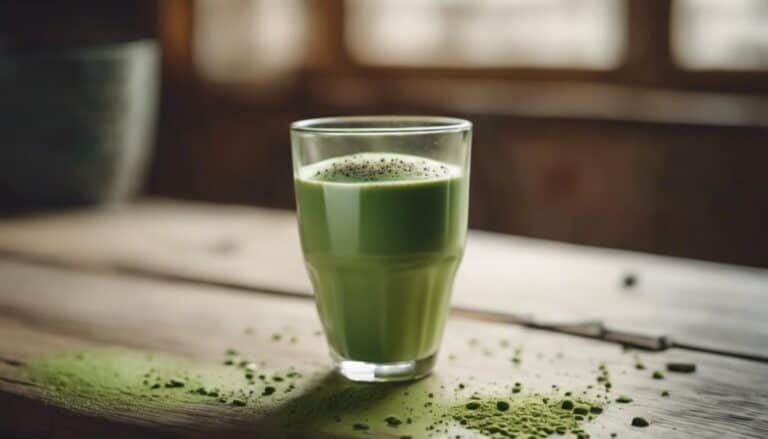Tea Vs. Coffee: the More Acidic Truth

As I sipped my morning coffee, I couldn't help but ponder the acidity levels of this beloved beverage compared to tea. The debate between tea and coffee enthusiasts often overlooks this vital aspect, leaving many to wonder about the impact on our bodies. The truth about which one is more acidic might surprise you, hinting at broader implications beyond just taste preferences. Let's explore this intriguing topic further to shed light on the acidic truth behind our daily brews.
Acidity Levels in Tea and Coffee
In comparing the acidity levels of tea and coffee, it's apparent that black coffee generally exhibits higher acidity than black tea. Black coffee typically falls within a pH range of 4.5 to 6, while black tea is milder, with pH levels ranging from 4.9 to 5.5. This difference in acidity can influence taste preferences and potential health implications. Understanding the pH scale is vital; beverages with a pH below 7 are deemed acidic, while those above 7 are considered alkaline. Green tea, however, stands out with a pH level around 10, making it notably less acidic compared to both black coffee and black tea.
The varying acidity levels in tea and coffee play an essential role in how these beverages affect individuals. For those with acid reflux or GERD, managing acidity intake is crucial to prevent exacerbating these conditions. When choosing between tea and coffee, considering their acidity levels becomes paramount for overall well-being and health.
Ph Comparison of Tea and Coffee
Comparing the pH levels of tea and coffee reveals notable differences in acidity, influencing their taste profiles and potential health impacts. Black coffee typically has a pH range of 4.5-6, making it more acidic compared to black tea, which falls between 4.9-5.5. Green tea, on the other hand, stands out with a pH around 10, indicating it's notably less acidic than both black coffee and black tea.
Understanding the pH scale is essential as it helps differentiate between acidic and alkaline beverages. Beverages like coffee and tea with varying acidity levels can impact factors such as heartburn and acid reflux.
The final acidity of tea and coffee can be influenced by factors like brewing methods, additives, and personal preferences. These differences in pH levels play a significant role in the overall taste and potential health benefits of these beverages, alongside considerations like caffeine content and the type of tea leaves used.
Health Implications of Acidity

Acidic beverages like tea and coffee can have significant health implications, particularly for individuals with conditions such as GERD. When contemplating the health implications of acidity in these beverages, it's vital to understand the pH levels and how they can impact our well-being. Here are key points to keep in mind:
- Acidity in Tea: Tea tends to be more acidic than black coffee, potentially leading to increased acid reflux and heartburn.
- pH Levels: Monitoring the pH levels of beverages can help individuals manage acidity-related health issues effectively.
- Acid reflux: Excessive acidity from tea or coffee can trigger acid reflux, especially in those with underlying sensitivity.
- Brewing methods: Factors like brewing techniques, additives, and steeping duration can influence the final acidity of tea and coffee.
- Health and Moderation: While moderate consumption is generally safe, maintaining a balance and being mindful of acidity levels is crucial for overall health.
Caffeine Content Variance
Tea and coffee exhibit notable differences in caffeine content, contributing to distinct effects on our energy levels and overall consumption patterns. Coffee generally contains higher caffeine levels compared to tea, with an 8-ounce cup typically containing 90-100mg of caffeine, while strong teas like black tea and matcha have around 70-90mg.
Green tea, in particular, contains l-theanine, which aids in moderating caffeine absorption, resulting in a smoother, more sustained energy boost compared to the sharp spike often experienced with coffee. It's essential to be mindful of caffeine intake, especially with coffee, to avoid potential side effects of excessive consumption.
Loose leaf tea, known for its higher antioxidant levels, generally contains less caffeine than tea bags, offering a healthier alternative for those looking to reduce their caffeine intake while still benefiting from the antioxidant properties of tea.
Acidic Impact on Digestive System

When evaluating the impact on the digestive system, it becomes apparent that the acidity levels of beverages like coffee and tea play a significant role in determining their effects on gastrointestinal health. When it comes to digestive issues, tea and coffee offer contrasting outcomes due to their varying acidic nature. Here are some key points to ponder:
- Tea, with its lower acidity levels, is generally gentler on the digestive system compared to coffee.
- Excessive acidity from coffee can contribute to digestive issues like acid reflux and heartburn.
- The pH levels of coffee are typically lower (more acidic) than tea, impacting how they affect the stomach.
- Consumption of green tea, known for its soothing properties, can help alleviate stomach discomfort caused by high-acid foods or beverages.
- Choosing tea over coffee can be a beneficial choice for those with sensitive digestive systems or acid-related conditions.
Opting for tea, especially varieties with lower acidity levels, may reduce the risk of stomach irritation and other digestive problems, making it a favorable option for individuals with sensitive digestive systems.
Factors Influencing Acidity Levels
Considering the importance of acidity levels in beverages like coffee and tea on digestive health, exploring the factors that influence these acidity levels is essential for understanding their impact on the body.
Various factors such as brewing methods, additives, the type and source of tea leaves or coffee beans, and even the addition of water or milk can greatly affect the acidity of these beloved drinks.
The pH levels of teas like black tea and green tea can vary, impacting their acidity. For instance, black tea can range between 4.5 to 6, while green tea can be around 10, affecting the overall acidic nature of the beverage.
Personal preferences and choices in brewing techniques also play a role in determining the acidity of tea and coffee, allowing individuals the freedom to customize their drinks to suit their tastes.
Choosing Between Tea and Coffee

When deciding between the two popular beverages, coffee generally exhibits higher acidity levels compared to tea. Understanding the acidity levels of tea and coffee is important when making a choice based on taste preferences and health effects.
Here are some key points to keep in mind:
- Coffee typically has a pH range of 4.5-6, making it more acidic than black tea, which falls between 4.9-5.5 on the pH scale.
- Green tea stands out with a pH around 10, making it noticeably less acidic than both black tea and coffee.
- The acidity levels in these beverages can impact taste preferences and potential health effects, with levels below 7 being acidic and above 7 being alkaline on the pH scale.
- Exploring different brewing methods can help customize the acidity of tea and coffee to suit individual needs.
- Balancing acidity levels in beverages like tea and coffee is essential for well-being, allowing individuals to tailor their choices to align with their specific preferences and health considerations.
Conclusion
In summary, understanding the acidity levels of tea and coffee is vital for making informed choices based on personal preferences and potential health considerations.
With black coffee being more acidic than black tea, and green tea having a lower acidity level than both, individuals can tailor their beverage choices to suit their taste preferences and overall well-being.
Consideration of acidity levels, caffeine content, and digestive impact can guide individuals in selecting the most suitable option between tea and coffee.





